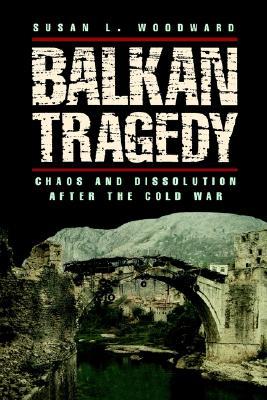There are two popular theories of how the war in Yugoslavia started. Dr. Susan L. Woodward in Balkan Tragedy shows how both are wrong, and gives us a well-documented and convincing history of the causes that led to the dissolution of Yugoslavia.
One opinion, widely held in this country, is that the fighting in Bosnia is part of a pattern of aggression by the Serbs against the legitimate governments of sovereign members of the United Nations. Internationally recognized borders have been violated by Serbs seeking the creation of a greater Serbia, meaning the incorporation into Serbia of portions of both Croatia and Bosnia, and the forced expulsion of non-Serbian populations (ethnic cleansing) from these areas. Such acts of aggression are clear violations of international law, and the aggressor should be punished. To this end the United Nations, often led by the United States, has imposed sanctions on Serbia, maintained an arms embargo, a no-fly zone, and brought other forms of psychological pressure to bear. In some ways the situation is analogous to that of Iraq or Libya.
The second popular view is that the conflict in Yugoslavia is really a civil war, based on hatreds that have been kept in a deep freeze by a totalitarian state. With the fall of communism, these ethnic conflicts have sprung up like repressed coil springs. This view is held in Europe and Canada, precisely those countries that have committed troops to U.N. peacekeeping efforts. In 1992, the Europeans tried to negotiate an ethnic partition of Bosnia into cantons; although they subsequently recognized Bosnia as an independent republic, they continued to maintain that only a political compromise could bring peace. Hence their forces in Yugoslavia are there for humanitarian reasons: to maintain some sort of cease-fire so that essential supplies can be brought to civilian populations and to set an atmosphere conducive to talks among the contending forces.
There are obvious contradictions in both of these theories. First, one may ask that if it is permissible for Croatia and Bosnia to secede from Yugoslavia, a member in good standing of the United Nations and one with internationally recognized borders, why is it not permissible for Serbian Bosnia to secede from a republic which had never existed before and whose borders had been drawn initially by a communist dictator? As for the theory of age-old enmities, some of it is simply not true. The Yugoslavia that arose after World War I was a result of the Pan-Slavism popular at that time. The Slovenes and Croats, anxious to divorce themselves from the Austrians and Hungarians, felt they had much in common with their Serbian cousins. True, there had been considerable animus between Turk and Serb for over 500 years, but in modern Yugoslavia both Muslims and Serbs coexisted reasonably well, with a significant rate of intermarriage. The Muslims did not call themselves Turks, and the term Yugoslav was popular in both groups. (Of greater import, of course, was the carnage of World War II, in which the Serbs suffered huge losses of population.)
Dr. Woodward states that the Yugoslav conflict is the result of transforming a planned economy to a market economy, and of a one-party authoritarian state to a multiparty democracy. Further, in a country where there is no majority and everyone is a member of a minority, the preservation of human rights becomes paramount. As difficult as the problem was, it became even more so with the changing international scene. Yugoslavia as one of the leaders of the Third World had been able to profit from the Cold War by receiving assistance from both sides. Despite this prolonged economic aid, however, it could never keep its economy consistently healthy, and found itself in a foreign debt crisis just as the Cold War was ending and the deep pockets of the United States and the Soviet Union were closing.
All through its post-World War II existence, Yugoslavia juggled with political reforms, at one time centralizing its economy, at other times decentralizing, but regardless of which way the pendulum swung, further reform seemed always necessary. In time the decentralization momentum became enormous, to the detriment of the federal government, where both its resources and its problem-solving ability were concerned, so that finally that government, bereft of authority, became a hollow symbol. Thus, concludes Woodward, it was a failure of political mechanisms that brought about the collapse of Yugoslavia and the breakup of the republics into ethnic entities. The West exacerbated the situation by failing to recognize that only through the federal government could Yugoslavia’s problems be contained, and, by assuming ethnic animosity to be the central problem, the West virtually assured that it would become so.
Woodward feels that supranational institutions requiring sustained interaction among people and sovereign states is the best system for resolving disputes. Thus a plan for the confederation of Croatian Bosnia with Croatia, and Serbian Bosnia with Serbia (vetoed by Germany and the United States because it “rewarded aggression”), seems to her a promising first step toward a greater Balkan confederation.
She is, of course, right, but while we can refrain from damaging a country’s capacity to govern, one may wonder how the West can improve that capacity. Economic aid has been the traditional method, and sometimes it has worked. Whether we have sufficient resources now to try to do that in the Balkans is questionable, and whether Humpty Dumpty can ever be put back together is equally doubtful. Nevertheless, some form of cooperation or confederation may eventually arise, and if so, the kind of knowledge Woodward provides us would be immensely helpful in nurturing it.
[Balkan Tragedy: Chaos and Dissolution After the Cold War, by Susan L. Woodward (Washington, D.C.: The Brookings Institution) 536 pp., $42.95]

Leave a Reply